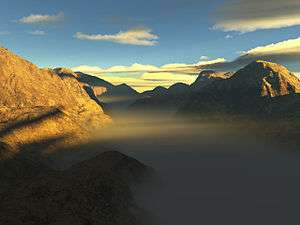Scenery generator

A scenery generator refers to software used to create landscape images, 3D models, and animations. These programs often use procedural generation to generate the landscapes. Basic elements of landscapes created by scenery generators include terrain, water, foliage, and clouds.
Common features
Most scenery generators are able to create basic heightmaps in order to simulate the variation of elevation in basic terrain. Common techniques include Simplex noise, fractals, or the Diamond-Square Algorithm, which are able to generate 2-dimensional heightmaps. However, cliffs and caves, due to their 3-dimensional nature, cannot be created using basic heightmap techniques, and are created by a variety of alternative methods. Bodies of water have their own distinct behavior, and form lakes, rivers, and oceans. They are either created separately as a unique aspect of the scenery, or are computed from existing elevations in the heightmap. Vegetation may also be simulated on top of the generated terrain, with the goal of achieving a natural landscape. Features such as trees or bushes are typically generated using L-systems or fractals, due to featuring a generic structure. Clouds and other atmospheric effects are featured in scenery generators less often, and are created using different applications of fractals and noise.
In addition to procedural methods, scenery generators such as Grome may also allow for users to manually edit terrain features, often according to sets of rules. A small number of software packages that do not generate terrain are often specialized to create specific aspects of it. Speed Tree, for example, is used to create only vegetation, while CityEngine specializes in creating realistic buildings and infrastructure.
Applications
Scenery generators are commonly used in movies, animations and video games. For example, Industrial Light & Magic used E-on Vue to create the fictional environments for Pirates of the Caribbean: Dead Man's Chest.[1] In such live-action cases, a 3D model of the generated environment is rendered and blended with live-action footage. Scenery generated by the software may also be used to create completely computer-generated scenes. In the case of animated movies such as Kung-Fu Panda, the raw generation is assisted by hand-painting to accentuate subtle details.[2] Environment elements not commonly associated with landscapes, such as or ocean waves have also been handled by the software.
Scenery generators in video games give a variety of benefits, due to their procedural nature. Large environments can be created for players to explore, while using little space to store the data. Certain games are also able to offer different kinds of landscapes that are constantly changing, allowing players a different experience between sessions. Alternatively, the content created by a scenery generator can replace scenery elements that would otherwise need to be manually created. Time and resources in the game's development cycle can be conserved by automating repetitive tasks, such as the generation of varied foliage. Virtual simulations such as non-commercial versions of America's Army also benefit from the use of scenery generators due to their need to provide realistic, predictable settings with emergent properties. Due to the role that scenery generation plays in many present-day video games, game engines such as OGRE or Unreal Engine 3 often include a means to generate scenery within their own packages.
Software
- Artifex Terra 3D,[3] freeware 3D terrain editor and painter based on the Ogre3D engine, brush-centric editing, triplanar texturing, able to import and export heightmaps.
- Bryce, 3D editing software famous for landscape creation.
- Grome, able to generate terrain, roads, water and additional decoration both manually and procedurally.
- Houdini, 3D editing software completely centered on procedural generation.
- Outerra, specializes in planetary generation.
- Speed Tree, software used for generating foliage for video games.
- Terragen, freeware for Microsoft Windows and Apple Macintosh which specializes in landscapes and planets.
- Terra Vista from Presagis is a terrain generation software tool for the rapid development of correlated visual, sensor, SAF/CGF, maps, and analytical 3D databases.
- SEGen Server from Presagis is a procedural modeling-based software tool for the low-cost development of large-area synthetic environments from minimal source data.
- VistaPro, which is able to use images of Mars and Earth in the generation process.
- Vue, a scenery generator that specializes in outdoor landscapes and animation.
- World Machine, a node-based generated terrain software with a plugin system to write user-defined nodes.
See also
- Brownian Surface
- Diamond-Square Algorithm
- Fractal landscape
- Simplex noise
- Perlin noise
- Random Dungeon
- Procedural Modeling